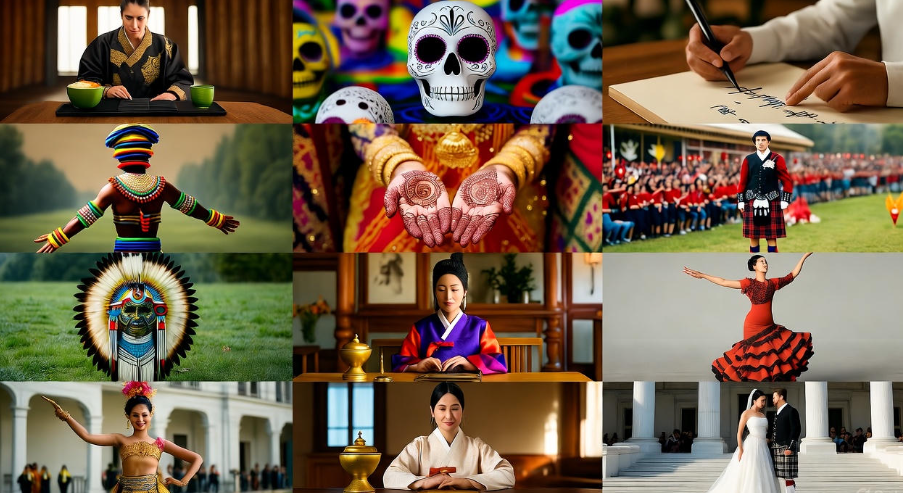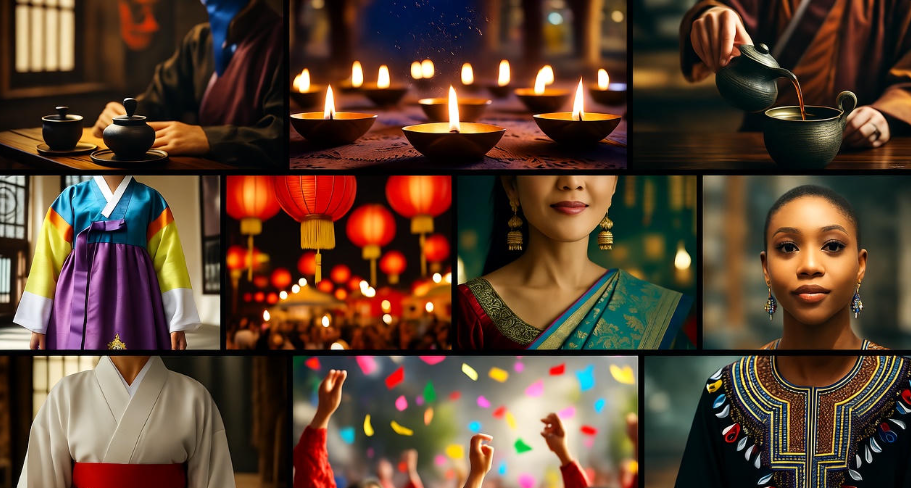Culture is what makes our world colorful. Every community has its own set of traditions — some joyful, some spiritual, and some deeply symbolic. These timeless customs connect generations, telling stories about where we came from and what we believe in. Let’s take a journey around the globe to explore 12 timeless cultural traditions that continue to shape lives today.
1. Japanese Tea Ceremony
There’s something magical about watching a Japanese tea ceremony. It’s not just about drinking tea — it’s about mindfulness, respect, and balance. Known as Chanoyu or Sado, this centuries-old practice is guided by the principles of harmony (wa), respect (kei), purity (sei), and tranquility (jaku).
The host carefully prepares and serves matcha (powdered green tea) to guests in a quiet, peaceful setting. Every gesture, every movement, has meaning — showing how even simple acts can carry beauty and intention.
| Symbol | Meaning |
|---|---|
| Matcha | Purity and focus |
| Bowl | Simplicity and humility |
| Silence | Meditation and inner peace |
This tradition reminds us that slowing down isn’t a waste of time — it’s an art.
2. Indian Diwali – Festival of Lights
Diwali, celebrated across India and in many parts of the world, is a festival that lights up hearts and homes. Known as the “Festival of Lights,” it symbolizes the victory of light over darkness, good over evil, and knowledge over ignorance.
Families decorate their houses with lamps (diyas), share sweets, and burst fireworks. It’s not just a celebration — it’s an emotion. Every diya lit during Diwali carries the hope for new beginnings and happiness.
Fun fact: Diwali is also the time when people buy new clothes and clean their homes — symbolizing renewal from inside out.
3. Mexican Día de los Muertos
If you’ve ever seen colorful skulls and marigold flowers, you’ve probably come across Mexico’s Day of the Dead — Día de los Muertos. Far from being sad, it’s a joyful tribute to loved ones who have passed away.
Families build beautiful altars (ofrendas) decorated with food, photos, and candles. The belief is that spirits return on this day to visit their families.
| Item | Symbolism |
|---|---|
| Marigold | Guide spirits home |
| Pan de Muerto | Bread of remembrance |
| ️ Candle | Light for the soul’s path |
It’s a celebration of life, love, and memory — a reminder that those who’ve left us never truly disappear.
4. Chinese New Year
The Chinese New Year is not just another holiday — it’s a time when families reunite, homes are cleaned of bad luck, and streets burst with red lanterns and fireworks.
Each year represents an animal from the Chinese Zodiac — like the dragon or the tiger — each with its own traits and symbolism. Red envelopes (hongbao) filled with money are given to children and unmarried adults to bring fortune and happiness.
It’s a time to honor ancestors, start fresh, and wish for prosperity in the year ahead.
5. Hawaiian Hula Dance
The Hawaiian Hula is more than a dance — it’s storytelling through movement. With graceful hand gestures and rhythmic swaying, dancers express tales of love, nature, and the gods.
Each movement in Hula carries a meaning. When the dancer waves their hands softly, it may represent the ocean. When they bend low, it might symbolize the earth.
Music, chants, and costumes combine to create a cultural art that keeps Hawaii’s ancient legends alive.
6. African Griot Storytelling
Long before books and the internet, Africa had the Griots — storytellers, historians, and musicians who kept history alive through spoken word and rhythm.
They traveled from village to village, narrating the tales of kings, wars, and wisdom. A Griot’s voice could unite people and teach lessons through melody and poetry.
Even today, this oral tradition survives in music, rap, and poetry — proving that words truly have the power to live forever.
7. Scottish Highland Games
If you’ve ever seen men in kilts tossing massive logs through the air — that’s the Scottish Highland Games!
These traditional gatherings blend sports, music, and culture. Events like the “Caber Toss” and “Stone Put” showcase strength and pride. Bagpipes play in the background, and clans gather in colorful tartans.
But it’s not just about physical strength — it’s about community, heritage, and celebrating Scottish identity that’s been passed down for centuries.
8. Native American Powwow
A Powwow is a sacred gathering for many Native American tribes. It’s filled with drumbeats, songs, dances, and beautiful traditional clothing that tell stories of their ancestors.
Each dance has meaning — some honor warriors, others celebrate harvest or the changing seasons.
The drum represents the heartbeat of the Earth, reminding everyone of their deep connection to nature and spirit.
These gatherings promote unity, respect, and the preservation of indigenous culture.
9. Turkish Whirling Dervishes ️
In Turkey, the Whirling Dervishes perform a mesmerizing spiritual dance known as Sema. Dressed in white robes and tall hats, they spin in circles to reach a state of meditation and closeness to God.
This practice comes from Sufism — a mystical branch of Islam. The whirling motion symbolizes the soul’s journey toward divine love and unity.
It’s both graceful and deeply spiritual — showing how movement can become prayer.
10. Spanish Flamenco
Flamenco isn’t just dance; it’s passion in motion. Born in Andalusia, Spain, it combines intense music, guitar, clapping, and emotional expression.
Every stomp, every turn, tells a story — often one of love, sorrow, or strength. The dancer’s face and gestures convey raw emotion that words can’t express.
Even today, Flamenco performances around the world remind us of Spain’s fiery cultural soul.
11. Balinese Nyepi – Day of Silence
In Bali, Indonesia, there’s a day when the entire island becomes silent — Nyepi. Streets empty, lights go off, and even airports close.
It’s the Balinese New Year, but instead of fireworks or parties, people spend the day in meditation, fasting, and self-reflection.
This unique tradition encourages inner peace and harmony with nature — something our modern, noisy world could learn from.
12. Moroccan Henna Night
Before a wedding in Morocco, there’s a special night dedicated to the bride — the Henna Night. Her hands and feet are decorated with intricate designs made from henna paste.
The designs aren’t just for beauty — they symbolize joy, protection, and good luck. Family and friends gather, music plays, and the atmosphere fills with love and blessings.
This tradition shows how art, beauty, and emotion can all come together in one celebration.

Why Cultural Traditions Matter
Traditions are not just rituals — they are the living memories of humanity. They remind us of our shared values, teach moral lessons, and connect generations.
Without them, we’d lose the stories that make us who we are.
| Benefit | Description |
|---|---|
| Identity | Keeps cultural roots alive |
| ❤️ Unity | Strengthens social bonds |
| Expression | Gives meaning to art and festivals |
| Balance | Encourages respect for nature and others |
Even in the age of technology, these timeless customs continue to remind us of what truly matters: connection, meaning, and respect.
A Few Thoughts
Isn’t it amazing how people from completely different parts of the world express the same human emotions — love, respect, faith, and hope — through unique traditions?
When you look closely, every culture shares one common goal: to celebrate life.
❓Frequently Asked Questions (FAQs)
Q1: Why are cultural traditions important?
They help preserve a community’s history, values, and identity. Traditions connect generations and teach younger people about respect, love, and belonging.
Q2: Can traditions change over time?
Yes, absolutely. Many evolve with society while keeping their original essence. That’s what keeps them alive — adaptation without losing meaning.
Q3: What’s the difference between culture and tradition?
Culture is the entire way of life — food, language, music, values — while traditions are specific customs or rituals passed down through generations.
Q4: How can I learn about other cultural traditions?
Travel, reading, festivals, documentaries, and even conversations with people from other backgrounds can help you learn and appreciate global traditions.
Q5: Are modern celebrations losing traditional value?
Sometimes yes, but many communities are bringing traditions back — mixing modern life with cultural heritage in creative ways.
Final Thoughts
Every tradition — whether it’s lighting a diya in India, sharing tea in Japan, or dancing the Flamenco in Spain — carries a heartbeat of humanity.
They remind us to pause, connect, and cherish what’s meaningful.
When we understand and respect each other’s traditions, the world feels a little smaller and a lot more beautiful. ✨




